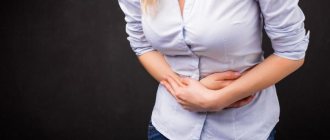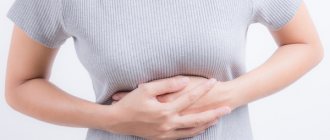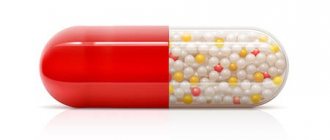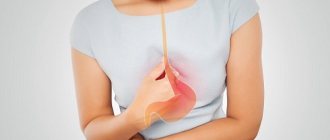Pain in the left hypochondrium
If pain is felt in the left upper abdomen, then it can be caused by a diseased stomach, pancreas or spleen. Inflammation of these organs is usually caused by pathogenic bacteria, as well as an unhealthy lifestyle and stress.
In addition, stabbing pain can occur during physical activity, and there is no underlying disease. The reason is improper load distribution.
Abdominal pain on the left due to inflammation of the gastric mucosa (gastritis)
If aching pain in the left abdomen most often occurs after eating, then this is a sign of inflammation of the gastric mucosa (gastritis). This pain occurs when the stomach is full of food. Then, as food passes further into the intestines, the pain subsides. Stress can also contribute to abdominal pain due to gastritis.
If the pain in the left hypochondrium is acute, occurs after eating and is accompanied by sour belching, vomiting, heartburn, and a feeling of pressure, then this may indicate a stomach ulcer.
One of the causes of inflammation of the gastric mucosa may be a bacterium called Helicobacter pylori. It can be detected during a medical examination.
Dull constant pain in the left hypochondrium
You should pay attention to such pain and undergo an examination, as it may be the result of an indolent disease of the gastrointestinal tract. Aching pain in the left hypochondrium can also cause a number of autoimmune diseases.
Pain in the left hypochondrium due to inflammation of the pancreas
If there is pain under the rib on the left, then the cause may be the pancreas. Its inflammation causes unbearable burning pain in the left hypochondrium, which radiates to the back. Sometimes inflammation causes girdle pain in the upper abdomen. The pain may subside slightly when you bend your torso forward in a sitting position.
The pain is accompanied by symptoms such as bitterness in the mouth, vomiting bile, darkening of the urine and lightening of the stool. Common causes of pancreatic inflammation include gallstones, cigarettes and alcohol.
Pain in the left side under the ribs in front
One of the causes of such pain may be intercostal neuralgia. This creates the impression of pain under the ribs. The pain can be of a different nature, dull, tingling, or move to different areas.
Upper left abdominal pain due to spleen disease
Enlargement and infarction of the spleen due to arterial thrombosis cause severe pain, which can radiate to the left shoulder. But as a rule, these diseases exhibit additional symptoms: fever, muscle pain, headache, swollen lymph nodes.
Heartburn in the stomach on the left side
If the stomach hurts on the left and this pain is accompanied by belching and burning pain spreading throughout the esophagus, then in medicine this disease is called reflux. Heartburn can be caused by increased stomach acidity, stress, snacking on the go and too fatty foods.
This symptom also occurs with weak diaphragm muscles.
Abdominal pain under the ribs
If you are suffering from pain in the upper abdomen, just below the ribs, it is most likely not caused by the abdominal organs. The lower sections of the lungs and the heart are located in this upper part of the abdominal cavity. Therefore, it is quite possible that pain under the left rib may be caused by pneumonia or even a heart attack.
However, with such diseases, abdominal pain is not the main symptom and other signs of disease necessarily appear. With a heart attack, these are symptoms such as chest pain, weakness, shortness of breath and cold sweat. The pain can travel up to the shoulder on the left side quite quickly. With pneumonia - pain when breathing.
What's there on the left side?
Left-sided pain in the upper quadrant of the abdomen (the area under the ribs, to the top of the ilium, the left part of the epigastrium) is manifested by lesions of the diaphragm, ulcerations of the gastric mucosa or gastritis, inflammation of the pancreas, diseases of the duodenum, and pathologies of the spleen. The origin of pain can be determined by additional signs. Discomfort in the lower part is caused by lesions of the urinary system, female reproductive organs, and large intestine.
Stomach pathologies
Inflammation and ulceration of the gastric mucosa are signaled by pain on the left if the pathological process is located precisely on the left wall of the organ. Aching pain occurs in the abdomen, the intensity of which increases. Further, the discomfort spreads to the entire upper part of the abdominal cavity, in the area under the stomach. The process is often accompanied by nausea, vomiting, and weakness. With gastritis, discomfort subsides after eating, with peptic ulcers it intensifies. Ulceration may be indicated by blood in the vomit. Perforation of the stomach will cause sharp stabbing or dagger pain.
Intestinal diseases
Inflammatory or ulcerative lesions of the small intestine may also cause pain. This symptom accompanies intestinal obstruction and volvulus. The changes provoke a feeling of heaviness in the abdomen, bloating, and periodic cramps. Pain also appears in diseases of the large intestine (descending colon): Crohn's disease, ulcerative colitis. In this case, changes in stool are observed: diarrhea, constipation, purulent, mucous, blood impurities, and pain is recorded in the lower left quadrant.
Spleen diseases?
The spleen is a parenchymal organ enclosed in a capsular membrane. Utilizes blood cells and takes part in immune responses. The following diseases of the spleen manifest themselves as left-sided pain:
- oncology - characterized by prolonged aching pain, sweating, increased body temperature, general weakness, apathy, weight loss;
- heart attack - develops when blood vessels are damaged or blocked by blood clots, accompanied by necrosis of spleen tissue around the site of injury, manifested by sharp pain and increased body temperature;
- volvulus - occurs when the vessels of the spleen are twisted and the blood circulation is impaired, characterized by intense stabbing pain radiating to the groin, nausea, vomiting;
- cyst - the formation of a capsule with liquid contents on the surface of an organ, manifested by aching and nagging pain that intensifies with physical activity; as the cyst grows, the discomfort increases;
- abscess - purulent-necrotic damage to the spleen, accompanied by stabbing pain; when the abscess ruptures, peritonitis occurs with extensive diffuse pain;
- expansion - the spleen can increase in size, often due to inflammation, less often - stagnation of blood, stretching of the capsule provokes stabbing sensations;
- rupture - the enlarged spleen is located almost immediately under the skin, external pressure (fall, injury, compression) can lead to rupture of the gland capsule, this is accompanied by dagger pain and bluish skin in the navel area.
In case of damage to the spleen, the patient accurately indicates the location of the pain. The sensations radiating to the groin cannot be confused with the true source of discomfort.
Pathology of the pancreas
The pancreas secretes enzymes to process protein, carbohydrate, and fatty foods. The organ can become inflamed due to poor nutrition, due to the irritating effects of bad habits (smoking, drinking alcohol), as well as other gastrointestinal pathologies (reduced activity of the bile duct, inflammation of the duodenum). The pancreas announces itself with sharp cutting or stabbing pains. They occur after eating fatty or hard-to-digest foods. The primary localization is in the left upper abdomen, but the pain quickly spreads to the right side and becomes encircling. The patient has a feeling that there is discomfort deep inside, and there may even be fears that the heart hurts. The condition is accompanied by nausea, vomiting, chills, particles of undigested food are present in the stool, and the skin becomes pale.
You can check the origin of the pain by placing the patient on his back. If the pancreas hurts, the sensation will become more intense, but the heart pain will not change in any way.
Gynecological sources of pain
An inflamed ovary may hurt in the lower left abdomen. As a rule, these are nagging and stabbing pains that become more intense after walking, running, or active housework. After rest, the pain subsides and becomes aching. During menstruation, the left ovary hurts more.
Mild pain accompanies the formation of a left ovarian cyst; it is periodic and increases with the size of the tumor. The pain becomes stabbing when the cyst pedicle is twisted or acute when the cystic capsule ruptures. In this case, there is likely to be an outpouring of fluid and blood into the abdominal cavity, and the appearance of vaginal discharge.
Another gynecological provocateur of pain is the localization of a fertilized egg (zygote) in the left fallopian tube - ectopic pregnancy. When the egg is implanted into the tube mucosa, slight discomfort occurs. As the cell divides, it increases, from aching to stabbing (at the stage of stretching the lumen of the tube). If an ectopic pregnancy is not eliminated in time, the tube will rupture, which is accompanied by severe pain and bleeding.
Urological problems
The passage of a stone from the kidney into the ureter or inflammation of the canal can provoke sharp nagging pain on the left, in the lower abdomen. Localization - closer to the groin at the ilium. It differs from other pathologies by frequent urination, the presence of blood, mucus, pus in the urine, chills, and the development of renal colic. If the stone is in the kidney, its movements provoke pain in the lumbar region, which can radiate down the abdomen. Symptoms are the same for women and men.
Much less often, left-sided pain occurs due to nerve compression or blockage of blood vessels by blood clots. Peritonitis can manifest as sharp and severe pain when hollow organs are damaged and their contents spill into the abdominal cavity. With peritonitis, the pain is diffuse - stronger at the site of acute inflammation, but felt almost everywhere.
In older men and women, left-sided pain may be caused by a diaphragmatic hernia. It develops when the diaphragm is weak and the upper part of the stomach protrudes into the lumen through which the esophagus passes.
What can hurt in the lower left abdomen?
If you feel pain in the left lower abdomen, this may indicate diseases of the colon, ureters or kidneys. Pain in the lower abdomen in women can be caused by problems with the uterus and ovaries. In men, such pain is caused by the prostate gland or testicles.
Pain due to colon diverticulum
One of the most common diseases of the colon is diverticulosis. Diverticula often go undetected during diagnosis. Their inflammation can cause stabbing pain in the abdomen.
The cause of pain is the ureters
Stones in the ureters or bladder cause sharp, paroxysmal, debilitating pain. They can sometimes give back.
Pain in the lower abdomen in women
In women, it is always necessary to take into account that the internal genital organs - fallopian tubes, ovaries and uterus are located in the abdominal cavity. Inflammation of these organs or cancer leads to constant sharp pain in the lower abdomen.
The gynecological nature of the pain can be indicated by disruptions in the menstrual cycle and pathological discharge from the vagina.
If you have persistent pain in the lower abdomen, you should consult a gynecologist.
Pain in the lower abdomen in men
In men, these pains may indicate inflammation or prostate or testicular cancer.
Mechanism of formation of abdominal pain
The feeling of pain serves as a protective reaction for the body. It indicates damage and requires help. According to the mechanism, pain impulses can be formed by:
- spastic contraction or hyperextension of hollow organs (intestines, stomach, bladder and ureter);
- an ulcerative process that violates the integrity of the submucosal and muscular layer (there are no pain receptors in the mucous membrane itself);
- stretching or rupture of the capsule of parenchymal organs (spleen, kidney);
- damage to nerve branches and plexuses (due to rib fractures, inflammatory processes, tumor disintegration).
Spastic pain is difficult for patients to tolerate
The classification of pain includes the following types:
- organ - caused by damage to one or more organs by inflammation, ischemia (reduced blood flow through the arteries), infectious process, pain in the left side of the abdomen migrates, does not have an epicenter and precise localization;
- parietal - connected to the abdominal wall, clearly localized at the site of the lesion;
- neurogenic - caused by damage to nerve fibers, distortion of the impulse to the brain, the organs themselves lying in the abdominal area may not be damaged;
- reflected - projected onto a zone that is connected by the location of the nerve ganglia of the spinal cord.
Pathology of the abdominal organs is caused by a mixed mechanism. One violation leads to a chain reaction. Knowledge of the combined negative process allows you to select the optimal treatment to counteract and reduce pain.
Stomach pain in the middle left
The causes of such pain can be appendicitis and food intolerance.
Pain from appendicitis
Appendicitis can also manifest itself as acute pain in the lower left abdomen. Although anatomically it is located in the lower right part of the abdomen, at the initial stage of inflammation, pain appears in the middle of the abdomen, near the navel. Then it moves to the lower abdomen and can be felt in both the left and right parts of the abdominal cavity.
Sometimes vomiting and nausea occur, and the disease can be confused with intestinal flu.
If the condition worsens, accompanied by fever, then it is necessary to call an ambulance.
Abdominal pain on the left or in the middle after eating
Abdominal pain after eating in the middle abdomen may indicate food intolerance. Most often, pain occurs some time after eating.
Food intolerance manifests itself through a feeling of fullness or stabbing pain after eating. Diarrhea or flatulence often appears.
Typical intolerances include fructose intolerance, lactose intolerance or gluten intolerance. Gluten is a protein often found in baked goods or pasta.
Abdominal pain due to intestinal infections
With intestinal infections, in the first stages of the disease, pain may appear in the left side of the abdomen, since the narrower left side of the colon more quickly signals problems with pain. As the disease progresses, the pain spreads to the lower right side and then covers the entire abdominal cavity.
With an intestinal infection, fluid loss due to vomiting and diarrhea can be dangerous. Therefore, it is important to drink plenty of fluids.
Table of symptoms and causes of abdominal pain on the left
| Abdomen area | Symptoms | Causes |
| 2 – left upper abdomen | Acute pain in the left abdomen, which can radiate to the back | Inflammation of the pancreas due to illness or large amounts of alcohol/cigarettes |
| 3 – left hypochondrium | Frequent belching, burning/tingling behind the sternum | Heartburn due to stress, fuss, high-fat foods, too weak diaphragm muscles |
| 4 – left upper abdomen to shoulder | Pain in the upper abdomen may radiate to the left shoulder | Splenic infarction due to arterial thrombosis or enlarged spleen |
| 5 – left lower abdomen | Stitching pain in the abdomen on the left side | Intestinal diverticulum |
| 4 - left lower abdomen | Acute pain in the left lower abdomen, sometimes back pain | Urolithiasis, passage of stones or sand from the left kidney |
| 5.6 – left side or entire abdomen | Abdominal pain on the left or pain in the entire abdominal cavity, nausea, vomiting, diarrhea | Intestinal infection |
| 6 - left side of the abdomen in the middle | Pain near the navel, in the left or right lower abdomen, vomiting and nausea, digestive problems, fever | Appendicitis |
| 6 - left side of the abdomen in the middle | Pain after eating | Food intolerance (fructose, lactose, gluten intolerance) |
| 7.8 – left lower abdomen | Pain in the left lower abdomen in women, vaginal discharge | Inflammation or cancer of the fallopian tubes, ovaries, or uterus |
| 9 – under the ribs | Chest and shoulder pain, depression, shortness of breath, cold sweat | Heart attack |
| 9 - under the ribs | Chest pain when breathing | Pneumonia |
Attention! Our website provides you with primary information on the topic of left abdominal pain. However, this information cannot replace consultation with a doctor. Any abdominal pain requires medical examination.
data-matched-content-rows-num=”4.2″ data-matched-content-columns-num=”1.2″ data-matched-content-ui-type=”image_stacked” data-ad-format=” autorelaxed">
What causes discomfort on the left side of the abdomen?
The left abdominal cavity is the place where organs and systems are located, the pathological sensations in which are similar. It is quite difficult to independently determine what is sick.
The causes of unpleasant symptoms are neoplasms and organ failures:
- Large intestine, sigmoid and rectum;
- The duodenum and part of the small intestine located on the left;
- Pancreas;
- Stomach;
- Spleen;
- Organs of the genitourinary system: left kidney, bladder, ureter.
Factors that provoke pain are mechanical damage to the tissues, walls of the abdominal cavity, ribs, nerves and blood vessels located on the left side.











